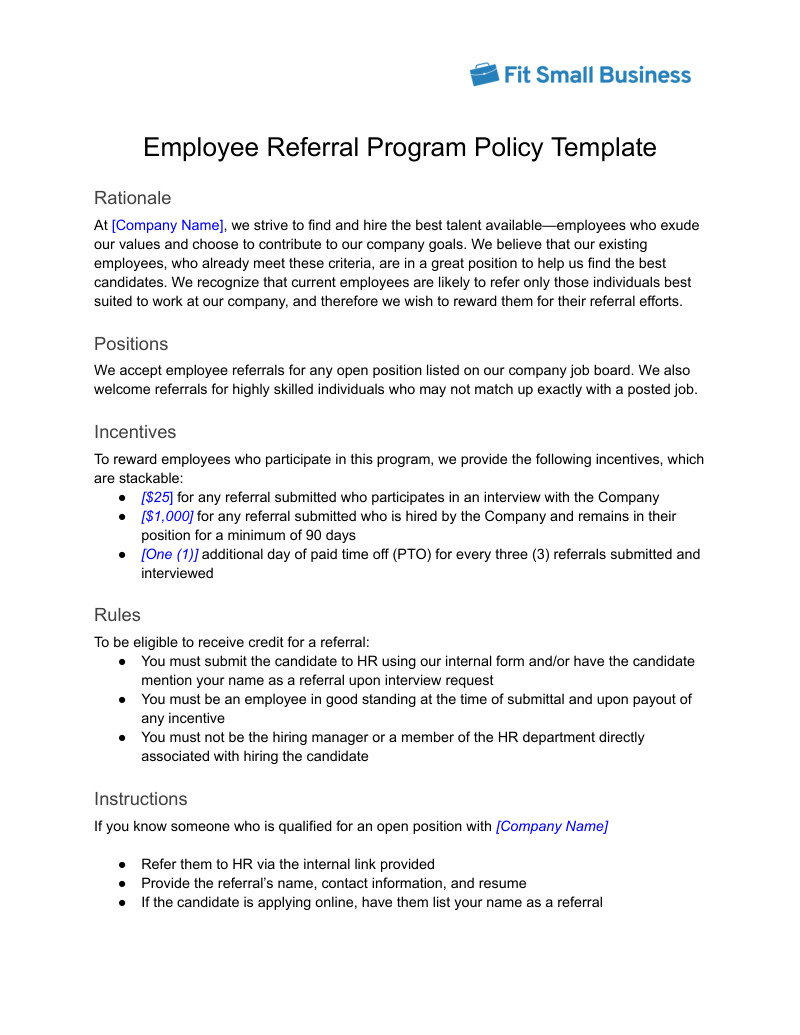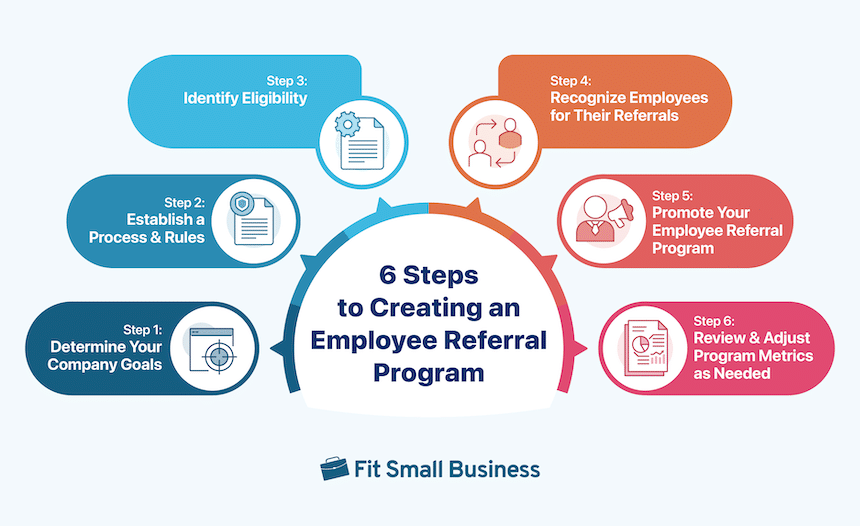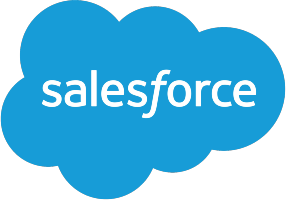An employee referral program involves asking your employees to refer candidates who may not have otherwise applied to your open roles and rewarding them for their referral efforts. With an employee referral, you gain access to higher-quality applicants—and may reduce hiring costs and time to hire—as most employees will only refer individuals they believe could excel at the job. Your ultimate goal is to get quality referrals from your employees through a straightforward process.
Download our free employee referral program template below. You can customize it to your exact policy requirements and incentives.

Thank you for downloading!
For help creating your employee referral program policy consider using Homebase. It offers everything you need to manage and pay your team–from scheduling to full-service payroll and policy creation–all in one place. Plus, try Homebase free for 14 days with is all-access trial.
To establish your own employee referral program, follow the steps below.

Step 1: Determine Your Company Goals
When determining goals for your company referral program, it is important to consider the desired outcome. Your goals should be concrete and measurable, so you can accurately track progress throughout the process.
The first goal you should consider is how many referrals you would like to receive from each employee. Setting realistic expectations will ensure that everyone is working toward the same goal.
Knowing what you want to achieve is key to developing an employee referral program that fits your needs. Here are some common outcomes you should expect:
- Reducing your company’s cost to hire
- Reducing your company’s time to hire
- Targeting passive job seekers
- Gaining access to a larger pool of qualified applicants
Step 2: Establish a Process & Rules
When you establish an employee referral scheme, keep it straightforward. If it takes employees too much time, or if they have to submit endless paperwork or online forms, they won’t do it—and you’ll miss out on potentially excellent referrals.
Keep it simple by using an online form to collect only relevant and necessary information:
- Employee’s name
- Referral’s name
- The open job title or requisition number
- The referral’s resume
- An open box for the employee to provide information about the referral
You will also need to create some rules around the program to eliminate confusion. For instance, if an employee refers someone your team has already contacted about an open position, they can’t claim a reward if that person gets the job. Additionally, if an employee makes a referral and then quits before the referral is hired, they should not be eligible for any incentive.
Step 3: Identify Eligibility
Generally, any full-time employee will be eligible to participate in the program, except hiring managers and HR representatives directly involved in the hiring process. Executives and part-time or seasonal employees may also be ineligible; however, you may want to offer an incentive to those with longevity and/or in certain positions within the company. Additionally, consider adding a clause to your policy that only employees in good standing will be eligible for any incentive.
Besides employees, you have another source of referrals—vendors and contractors. They are familiar with your business and will be more inclined to refer candidates if you reward them. While this should be a separate policy so as not to blur the employment relationship line and to ensure higher employee incentives, an external referral program can be a good supplement to your recruiting toolbox.
Step 4: Recognize Employees for Their Referrals
This is where you get to have some fun. You might naturally think of cash bonuses for referrals—and many employees will like that idea—but you can expand to other rewards. Examples include:
- Additional paid time off (PTO)
- Gifts or gift cards
- Random drawings for larger prizes
Ultimately, most employees will want a cash reward. How much you decide to pay may depend on several factors. Generally, the amount of cash rewarded would depend on how difficult the role is to fill or the type of position (i.e., an entry-level hire may have a referral bonus of $500 to $1,000, whereas an executive-level position may carry a higher referral bonus of $2,500 or more). If that’s the path you choose, make sure you include tax information in your policy so that employees know any reward they receive will be taxed as a bonus.
Your policy should also stipulate when rewards are paid. Employees may want their reward as soon as a referral is hired. However, you’re better off making sure the referral meets your expectations. We recommend you pay referral bonuses only after a referral has been on the job for at least 90 days.
Step 5: Promote Your Employee Referral Program
Your team must understand the referral process and how it benefits them. If you don’t properly convey the program, it may not give you the results you seek. Whether you, HR, or individual managers roll out the new policy and process, you need to determine how you will communicate and promote the initial plan and keep employees updated on referrals they have submitted.
Here are some tips to ensure your program is communicated clearly and that the process is clear and accessible to everyone:
- Show employees the benefits (gift cards, cash bonuses, or whatever you choose).
- Explain why the program benefits the company (better and more skilled hires, less turnover, and lower hiring costs).
- Keep forms to receive referrals in a place that’s easy for employees to find, such as a shared folder.
- Send an email with a descriptive subject line, and put the link on your company intranet or electronic message board.
- Create an internal marketing drive to promote your employee referral program. This will help keep the program front of mind for your employees and ensure they always have the relevant information near the top of their inboxes.
- Send a quick but informative email several times per quarter to keep employees engaged in the referral program.
Step 6: Review & Adjust Program Metrics as Needed
Data is key to any business venture. Your internal referral program is no exception. You should track:
- How many employees have been hired as a referral
- The time to hire for referrals vs applicants from job boards
- The number of employees who have submitted referrals
- The retention rate of referrals vs employees from other sources
- How many referrals have been interviewed
- The level of candidate diversity
- The total sum paid out to employees as a referral bonus
- Employee satisfaction with the referral program
Once you evaluate the data collected, you may see gaps that need to be addressed within your program. Take the time to fix them so that your referral program runs smoothly.
Transparency is key to overcoming this challenge and making sure that employees are updated on where their referral is in the process. Through your regular internal marketing of the program, you can keep employees informed of how many referrals have been received and interviewed for each open position.
What to Include in Your Employee Referral Program Template
When drafting your employee referral program template, include the following information:
- Rationale: The first section of your program template should explain why you are implementing the program. Let employees know you value their work and ability to provide qualified candidates to fill open positions.
- Positions: Most companies will allow referrals for any position. However, if your company has policies that prevent rewards for certain referrals (such as part-time, seasonal, or top executive positions) be sure to mention that here.
- Incentives: Whatever type of reward you plan to give employees goes in this section. This can be a monetary bonus or other type of gift, such as extra PTO days.
- Rules: Be sure to explain to employees how they can receive a bonus. Include how to submit a referral and the requirements to be eligible.
- Instructions: List out instructions for the employee on how to submit their request to HR or the hiring manager and what documentation is needed.
Benefits of a Good Employee Referral Program
One of the most important recruiting statistics you need to know is that a referred candidate is 18 times more likely to get the job. That’s because referrals are generally higher-quality candidates than you’ll find by advertising a job on job boards. Employees will only submit a referral if they are confident the individual can excel in the position.
Here are the three biggest benefits you’ll see from an effective employee referral program.
- Increases employee engagement: A referral will often better match your company culture, which in turn will create increased employee engagement. An existing employee who is already a good fit for your culture is more likely to refer someone similar.
- Expands quality of applicant pool: One of the biggest challenges hiring managers face when reviewing applicants from a job board is the sheer number of unqualified people who apply. Referrals, however, are in the unique position of understanding your company’s values, mission, and culture, as well as the intangibles for the open role. This makes employee referrals higher quality and more likely to be successful if hired.
- Saves time: With referrals, you will not have as many candidates as with a public job posting, making it easier to quickly review each and determine whether you want to conduct an interview. This saves your internal HR team time in finding high-quality employees and lets them focus on maintaining your company culture and benefits, like your employee referral program.
Legal Considerations
An employee referral program can provide you with a great additional source for talent acquisition and reduce your costs to hire. Making sure that you establish clear guidelines and criteria, however, will help ensure compliance with federal and local employment laws and regulations.
Specifically, a big legal issue you need to be aware of is making sure that you’re not discriminating against protected classes. The best way for you to avoid unintentional discrimination is to keep using multiple sources to hire, adopt blind hiring techniques, and not rely only on your employee referral program.
You need to track your employee referral diversity. If you find that 95% of your referrals are white men, you need to reevaluate your program, making adjustments to ensure diversity.
Employee Referral Program Examples
To be successful, your employee referral program needs to be well thought out and convey exactly what an employee will receive for referring a candidate who becomes a new employee. Some companies got it right and have had huge success with their internal referral programs.
Employee Referral Program Frequently Asked Questions (FAQs)
The program should outline expectations, rewards, and outcomes. Make clear to your employees how they should refer potential candidates, what incentives will be rewarded, and what timelines are required.
An employee referral program is an internal process that makes it possible for employees to refer friends, family, and professionals from their network to your company to help fill your open positions.
Referral programs do work. When employees submit referrals, you gain access to a large supply of passive candidates, who make up the vast majority of the workforce. And, with the right promotion and rewards, a company referral program is a win for both the employer and the employee. However, one reason employee referral programs sometimes fail is that employees don’t know what happens to a referral once they submit the name.
Bottom Line
Employee referral programs can give your company a boost in the quality of employees while improving employee morale and engagement. Providing incentives for employee referrals will inspire your team to become your best ambassadors. Monitoring your program and tracking specific data will ensure your employee referral program remains a key pillar of your success.


